“ZIL” refrigerators: brand history + secret of longevity
The USSR collapsed long ago, many factories modernized or completely replaced production lines that produced household appliances.But some engineering projects still surprise with their reliability, despite non-ideal operating conditions.
One such example is the ZIL refrigerator - a truly “indestructible” appliance that can still be found in the kitchens of our apartments or dachas. What is the secret of such longevity? Let's try to figure it out.
The content of the article:
History of production of ZIL refrigerators
The starting point for the production of domestic compression refrigerators running on freon is considered to be the Decree of September 7, 1949, by order of which a design bureau was created at the Moscow plant named after J.V. Stalin.
It was here that drawings were developed and prepared for the manufacture of small 85-liter Saratov units and more capacious 165-liter ZiLs.
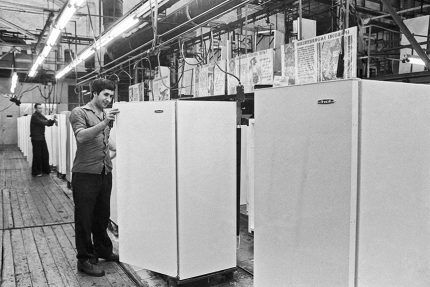
The prototype for the first ZiS-Moscow refrigerator was a pre-war model produced in the USA. One of the “premiere” devices, by the way, was presented to Brezhnev and received high praise from him.
But in the difficult post-war times, people were not able to purchase expensive equipment - the plant initially had serious problems with sales, but after a couple of five-year plans, the queue for products was scheduled for many years in advance.
More than 5 million ZiLs were assembled at the Likhachev plant, but after the collapse of the Union, foreign manufacturers appeared on the market.
Domestic technology could not compete with them due to interruptions in financing new developments and incorrect marketing policies.
In order to stay afloat, management began to reduce the quality of products and “turn a blind eye” to various defects, which immediately affected consumer demand.

In 2016, the legendary Likhachev plant celebrated its centenary, but there is no talk of restoring its production capacity - most of the workshops were demolished for the construction of a new residential neighborhood.
Reasons for the popularity of ZiLovs
The main secret of the longevity of Soviet refrigerators is the high quality of all parts, from body materials to all components.
For a long time, these devices belonged to elite equipment, not accessible to everyone: a third of the produced volume of products was sent for export, the same amount was sold in Moscow, and the rest was sold according to orders for high ranks from various cities of the Union.
Advantages of ZIL refrigerators:
- stylish (for that time) appearance;
- high-quality assembly;
- thick-walled, strong body;
- durable, height-adjustable, non-absorbent, easy-to-clean shelves;
- loyalty to voltage drops in the network;
- easy disassembly and high maintainability.
Each product underwent strict quality control. Even a fully functional device could be rejected if there were only minor scratches or minor irregularities in the welded material of the body.
But at other factories producing refrigerators, such nuances were not considered defects.
[adinserter name=”desktop: insert in text – 2 “]High standards were applied to all details. There are known cases when entire cars with blanks were rejected, on which stains or deviations in surface color were found.
Components that did not pass inspection were redirected to other, less “fastidious” factories. Such a tough position was the main reason why the ZIL brand was for a long time considered the manufacturer of the most reliable refrigerators in the Union.
Design features of various models
At the Likhachev plant, several lines of ZiLs were created, each of which had its own undeniable advantages at that time.
Of course, there were some drawbacks, but in terms of service life, Soviet refrigerators are far behind modern appliances, and many of them still serve their owners faithfully. Let's take a closer look at the ZiL model range.
No. 1 – the first bird “ZiS” DH-2
The flagship of the enterprise was assembled at the plant from 1951 to 1960. The first “swallow” of the design bureau of the plant named after. Likhacheva had a small freezer with a volume of 8 liters, a stainless steel evaporator and a reliable steel condenser.
The body with rounded corners and streamlined shapes was made of welded steel 8 mm thick and protected from corrosion by a layer of silicate enamel. The characteristic “highlight” of the model is the massive handle, which could be used as a lock.
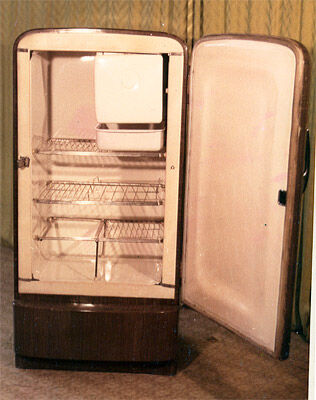
But the plant’s “first pancake” also had significant shortcomings:
- The normalized temperature was not maintained in the freezer (the device did not even reach the stated value of -6 °C in hot climates).
- A huge amount of metal was used in production.
- The unit itself was massive, heavy and took up a lot of space in the kitchen.
- At that time, a volume of 165 liters was considered unreasonably large (consumer demand for 85 liter models was much higher).
But over time, when people appreciated the advantages of storing food in the refrigerator instead of a string bag outside the window, this disadvantage not only turned into an advantage, but also served as an impetus for the development of more capacious appliances.
Few such refrigerators were produced - about 50 thousand per year. And today this model is considered a rare piece of equipment.
There is a known case when in Kazakhstan it was possible to sell a unit for almost 1 million tenge, but this was more likely a happy accident than an adequate price for the device.
No. 2 – improved “ZIL-Moscow” KH-240
The second model of the plant named after. Likhachev was produced in 1960-1969, and production volumes increased significantly due to already high demand and the best advertising - positive consumer reviews.
Refrigerators in this line had a total volume of 240 liters, and the capacity of the low-temperature compartment increased to 29 liters.
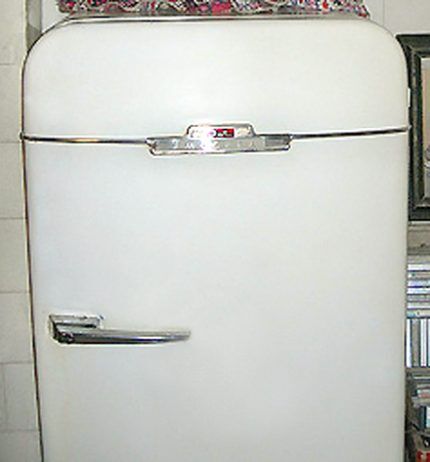
In addition to increasing the usable volume, the modernized ZiL had 4 duralumin shelves for dishes of various sizes, illuminated and varnished.
There are also trays for eggs, a place to store butter and “nests” for bottles. A pull-out metal tray was installed at the bottom of the refrigerator for fresh vegetables/fruits and other chilled foods.
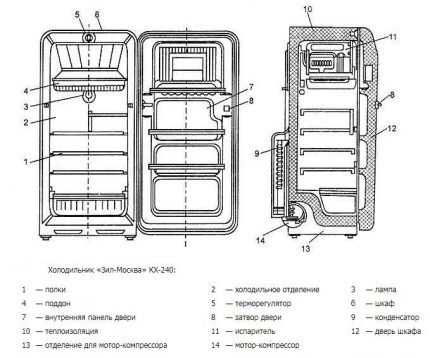
In addition, the designers corrected many of the shortcomings of the previous model and increased the shelf life of provisions due to the temperature set for NTO at -10 degrees.
[adinserter name=”desktop: insert in text – 3 “]The doorway was covered with plastic overlays, and thin fiberglass was used as thermal insulation material.
Hermetic closure was ensured by an elastic rubber seal installed around the perimeter of the inner wall of the door and a trigger shutter.
No. 3 – rectangular “ZIL-62” KSh-240/26**
In the third ZiL model, the appearance of the unit has changed significantly. It turned out that despite the attractive rounded lines, the design of the device does not allow it to be compactly placed in small-sized Soviet kitchens.
Therefore, the shape of the body took on the appearance of a rectangle with clearly defined right angles.
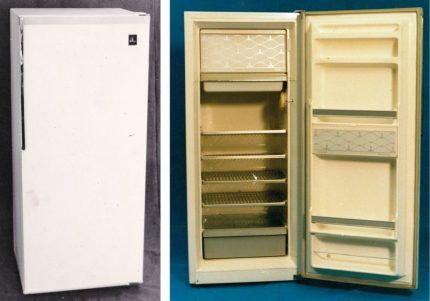
At the same time, the volume of the device remained the same - 240 liters, but the new models could be installed in one block with a kitchen set, and the upper surface could be used as a shelf (objects constantly fell from the previous sloping forms).
In addition, the rubber seal on the doors was replaced with a magnetic one, which is still used on almost all refrigerators today, and the width of the body was brought to the standard - 60 cm.
Disadvantages of ZIL-62:
- Outdated model compressor, famous for its loud “sound” during operation.
- Poor quality of thermal insulation, which did not allow a significant reduction in the thickness of the walls of the housing and led to the appearance of a snow “coat” on the freezer.
- Shelves that made it difficult to store food in non-standard containers.
- New “traumatic” handle design with sharp edges.
In addition, the developers were unable to eliminate the main production problems of previous versions - high metal consumption and labor-intensive manufacturing.
No. 4 – “transitional” version of “ZIL-63”
With the appearance on the Soviet market of the first two-door models “Minsk” and “Oka” with an auto-defrosting system and a volume increased to 300 liters, the demand for “ZiLs” fell sharply.
Therefore, the design bureau of the plant named after. Likhachev was instructed to create a project for a three-chamber refrigerator that could compete not only with domestic, but also foreign devices.
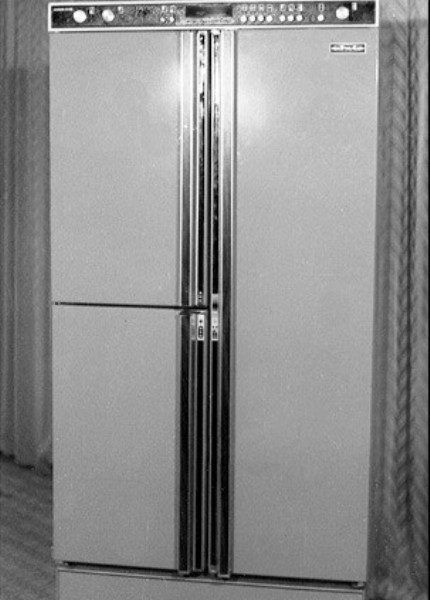
The design of new devices was developed together with specialized institutes, and to replace an outdated compressor, a license was purchased from the American brand Tecumsen.
But, as it turned out, the industrial capacity of the plant was not ready to implement the promising project - it “stalled” as soon as it became clear that it would be necessary to build a new workshop and purchase a production line for the then scarce currency.
[adinserter name=»desktop: insert in text – 4 «]Therefore, based on new developments, a model of increased comfort was released - “ZIL-63” KSh-260/26**, which was assembled at the plant until 1988.
And although the device was conceived as a transitional model before the launch of a fundamentally new refrigerator, high demand and excellent profitability indicators “delayed” its production for 12 years.
The management was satisfied with the high sales volumes, so promising developments were put aside.
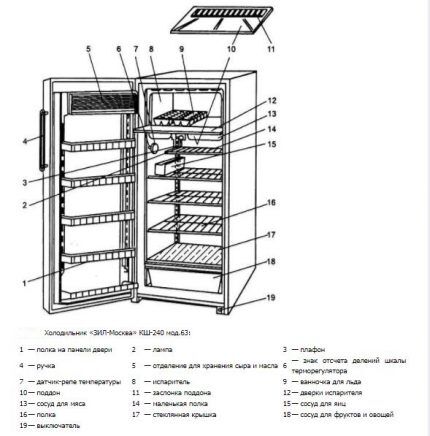
A compression refrigeration unit was installed in the Zil-63, and the compressor and an asynchronous electric motor with a starting winding were mounted on a spring suspension and hidden under a common casing.
Advantages of the new line:
- improved thermal insulation;
- noise reduction - the machine compartment of the device began to be covered with a sound-absorbing shield;
- shelves made of metal rods, comfortably adjustable in height in increments of 3 cm;
- increase in useful volume by 20 liters;
- the ability to “hang” the doors in a convenient direction;
- Lightweight removable handle of convenient length.
In addition, the device was supplemented with numerous comfort elements - a small shelf for small products, compartments for butter and cheese, a tray for 15 eggs, and a maximum door opening limiter of up to 105 degrees.
As well as adjustable rollers for transportation, a mold for making ice, a container with a glass lid for preserving fresh vegetables and fruits.
The disadvantages included the remaining manual defrosting, a reliable and durable, but outdated compressor, which was still manufactured at the plant itself.
But the persistent use of backward technologies and the cessation of continuous improvement of their product took away the “palm” from ZIL refrigerators.
You can get acquainted with modern two-door refrigerators in this article.
No. 5 – representative of the “transitional” line of “ZIL-64”
Since 1988, the modernized ZIL-64 KSh-260/30 models, which were produced until 2001, went on sale.
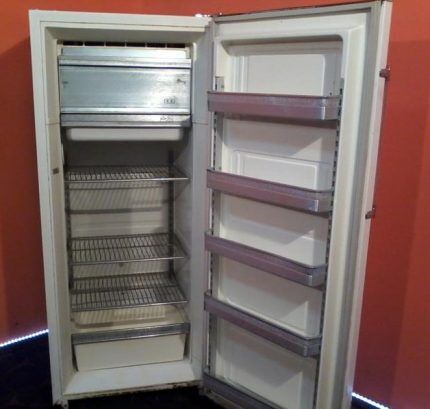
These refrigerators already have an automatic defrosting function, improved polyurethane foam insulation and the ability to reduce the freezing temperature to -18 degrees.
The volume of NTO was increased to 30 dm3, it now has a dividing plastic shelf for rational placement of products.
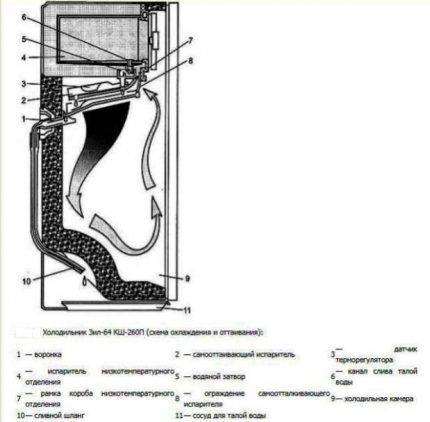
But these devices were unable to compete with foreign manufacturers for a long time, so their production was stopped.
[adinserter name=”desktop: insert in text – 5 “]Despite their reliability and build quality, the “old” ZiLs also fail.
But even here they have a slight advantage over modern technology: the devices are easy to disassemble yourself, and consumable parts are inexpensive, although over the years there may be problems with purchasing them.
Conclusions and useful video on the topic
For more information about famous refrigerators, watch our video collection.
History of the Soviet brand of refrigerators “ZIL”:
Replacing the thermostat for ZIL-64:
How to make a stylish rarity out of an old device - restoration of the ZIL body:
Despite their glorious history, the ZIL models are long outdated and cannot be compared with modern refrigerators in terms of capacity, quiet operation, or ease of defrosting.
But if you have such a rarity, do not rush to part with it - some workshops offer services for modernizing old devices and will be able to turn your ZIL into a stylish highlight that will decorate the interior of a cottage or apartment in a vintage style.
Still have questions about the topic of the article? Or can you supplement our material with interesting information? Please leave your comments, ask questions, share your experience - the contact block is located below.




If Stalin gave instructions, they would still be doing something bad! They feared him like fire and respected him, despite what he did to the people. Yes, refrigerators are cool, of course. They still stand in provincial hospitals in the wards where patients place their products. The old people are working, it will do. When there is nothing better, the old will do. An old horse, they say, does not spoil the furrows. )
It’s true, before everything was done conscientiously. It was difficult to get, but the quality is excellent. But now it’s the other way around: the market is oversaturated with household appliances of dubious quality.I recently bought a refrigerator, and after half a year the motor died, then the electronics stopped working. Well, how can you do that? Why does this happen when progress does not stand still? The old Zil refrigerator worked for more than 30 years and will work for the same amount of time. The “new” ones never dreamed of this.
Good afternoon, Vadim. Unfortunately, these are current trends. The household appliances market is structured in such a way that after the warranty period, it is most often necessary to replace the old model with a newer one.
The main disadvantage of the latest refrigerators is the lack of possibility of serious repairs. All the main components are located in the hull casing, which is difficult to reach. It will not be possible to restore the original thermal insulation after such a repair.
The first No Frost models are more reliable. An important factor is the ability to eliminate serious damage.
I have a Minsk 12, 1980 refrigerator. There have been no repairs yet. Of course it’s not “frost”, but otherwise it does its job.
I have a ZIL-62 KSh-240 refrigerator that has been working since 1978, and it’s already 2019! This is how to make a technique that will last forever!
Here in Leningrad, the family ZIL-Moscow 1964 is still working properly.
"ZIL-Moscow" KH-240, manufactured in 1968, is still plowing, although for the last 15 years at the dacha. My father also received it as a WWII participant. During all this time, only the handle broke and the rubber band became stiff - they changed it and that’s it! Who has more?
Tell me, where did you buy the elastic band? It really needs to be changed. Also from 1968 and at the dacha.
Be careful with ZILs, there are many cases where children get in and quickly suffocate. You can't open it from the inside, and the refrigerator is sealed.If it just stands there, remove the lock. If you throw it out, remove the door or remove the lock.
Saratov-II. Works for me in Tashkent since 1966)
Who knows: how much did the Soviet refrigerator ZIL 62 weigh? At least approximately? The one with the quality mark was...
The body is made of 8 mm steel sheet?!!!
Missed anything? Thick as a finger? Is it armor-piercing?
Do they transport it on a trailer and lift it with a truck crane?
0.8 mm. Why do you react like that, well, they made a typo, it happens.